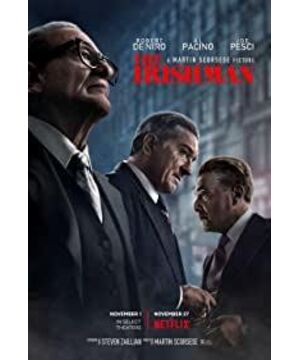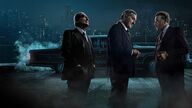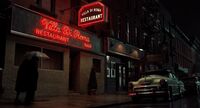"The Irishman", which is more than three hours long, is like a pot of simmering broth. It can't make people drink it, but it can make you feel the long-lost fat and thick flavor.
The "time-type" art of film has always been adapted to the aesthetics and habits of contemporary people. Movie creators usually shoot according to prototype standards. For example, a 120-minute scene has 40 to 60 scenes, and the scene needs to be changed almost every two and a half minutes. For example, the spiral alternation concept must start with an stimulating event, and after the rise of the plot, the sink must be ushered in and vice versa.
When the Lumiere brothers brought "Train into the Station" to the audience, the film has developed a mature industrial system for more than one hundred years. The contemporary era we live in is the pinnacle of industrial technology, and popcorn movies have repeatedly achieved good results at the box office with a sense of refreshment. Most moviegoers who regard movies as a pastime will undoubtedly prefer movies that do not require much thought and can "walk" with this "time-to-art" art.
Martin Scorsese thought that Marvel movies were not movies. It’s not surprising that he said this, because "The Irishman" proved that he was really not too impressed with Marvel movies, because if a movie keeps speeding up and has a lot of special effects to attract people, it will definitely make The story loses a bit of humanity.
We are fortunate that there are movies like "The Irishman" in this era, not because of its length and ignorance of the market, but because such movies can slow down our eyes and lift our eyes in an old-school atmosphere. Raise Erlang's legs to feel the gangster stories from decades ago.
Milan Kundera once raised doubts in the book "Slow", "How did the fun of slow go missing? Ah, where are the people who wandered in ancient times? The idle heroes in the folk song minor, these roaming mills, Where are the homeless people who spend the night in the open air? Have they disappeared along with the country roads, grasslands, glades and nature?"
But we have to ask the other way around, can "slowness" really produce different kinds of fun? Let's take a look at "The Irishman".
"The Irishman" is a movie with a stream of consciousness style. It will even give people the feeling of reading Proust's "Reminiscence of the Years". The protagonist Frank (Irish) first appeared as an old man with white hair, and he began to tell stories from the past. Later, when the picture turned around, we saw a common bridge segment in road movies. Frank and Russell took their family to travel by car. Their destination was to attend the wedding. Frank kept collecting envelopes from the store along the way, and the two ladies Several times asked to get out of the car to smoke.
Audiences who have watched the "Green Book" movie should be interested in this scene. Although the family trip of Frank and Russell is not as interesting as the pair of CPs in "Green Book", it is a whole story. The most relaxing segment of the movie. And the movie has shuttled back and forth in three time and space since then. Sometimes we can see Frank doing "wall painting" work when he was young, and sometimes from his middle-aged image to see how politicians like Jimmy influenced the United States at that time, and sometimes You can learn about the past history and feel the vicissitudes of life from the mouth of old Frank.
This kind of shuttle back and forth on the timeline can easily create a sense of confusion for the audience, which directly determines that "The Irishman" is not a very popular movie. Either you have some understanding of stream of consciousness techniques, or a little knowledge of modern American history, or you have to have amazing memory and recognition ability to draw personal coordinates. If you don't have it, you probably won't know what the story is about until the last few tens of minutes.
In the novel, both James Joyce's "Ulysses" or Marcel Proust's "Reminiscence of the Water Years" have caused such confusion to readers. The characteristic of the stream of consciousness is that time is not the most important story coordinate. Proust uses various memories at different points in time to bring out happy times. Joyce uses the turbulence in the consciousness of the characters to make his story indistinguishable. Borges, a latecomer, simply gave up the line of time and turned the story completely from the outside to the inside.
Of course, Martin Scorsese did not achieve this point, because movies and novels are different, the latter can construct a reasonable story through inner depiction, but the former must give people a sense of picture. The images we saw in "The Irishman" all came from Frank's memories, so we were substituted into a story with Frank, that is, the Irishman, as the main perspective.
Martin Scorsese presents Irish people in three age groups. Frank appeared on the scene as a truck driver in his first age. He colluded with the gang and stole beef. With the help of a lawyer from the gang, he was not only acquitted, but the prosecution was warned and punished by the judge. This is Frank's evil. Start. After that, he took his daughter to beat the store employee who dared to push his daughter, and almost burned a factory, which almost cost him his life. At this time, Russell appeared on the stage. He knew through observation for a period of time that Frank would be a gangster, so he used his life-saving kindness to join Frankl in the gang and became the killer in the gang.
In the second age, Frank was more involved in political struggles. He assisted Jimmy, and finally killed Jimmy for the benefit of the gang. This was also the most struggling stage of his life, because Frank, who had turned into an Irishman, had already regarded Jimmy as his best friend, but his obedience (he had been a soldier) forced him to do the most extreme behavior.
Martin Scorsese has always used restraint to avoid emotional leakage. It was the same when Frank killed Jimmy, and it was the same when his daughter Peggy broke with him. So we can see that, except for the politicians’ impassioned speeches on the podium, the whole movie has no great ups and downs. Even when Frank killed Jimmy, the successful Jimmy went back to see Russell without saying a word, as if It was an unrelated person who was killed.
This restrained performance method does not conform to the rules of current commercial films. Many directors like to act as masters of provocative emotions, and even use the laughter and tears of the audience as a measure of whether a movie's strength has reached the standard. "Avengers 4", which was not liked by Martin Scorsese, had two violent emotional ups and downs when Black Widow and Iron Man died, and the audience was not surprised to have many tears in the theater.
In "The Irishman", only subtle movements come to the audience to discover and deliberate on their own. For example, Frank deliberately glanced at the car outside when he walked into the house and the connector was round, because the disappearance of the car represented the cancellation of the mission, so he did not need to kill. Jimmy; Frank looked at his hand without listening while driving. It was wearing the watch Jimmy gave him and the ring Russell gave him. This is a suggestive psychological game; and the news of Jimmy’s death was broadcast on TV. Later, his hand movements and different expressions from the past made her daughter Peggy understand that the person who killed Jimmy was her father. Even the break between Peggy and Frank seemed a little understatement, there was no crying or screaming, only hiding in the dark.
This kind of restraint runs through the whole film, and when we enter Frank’s twilight period, we do not see Martin Scorsese portraying the tragedy of Frank and Russell and others in their twilight years, making it form the power of their prime. Compared. Instead, Frank told the story of the past like a homely old man.
The extraordinary control of Martin Scorsese and the actors is evident from this. Of course, these are all built on the basis that the story itself does not require additional atmosphere rendering. This is also the consistent tradition of gangster films under his lens, advanced and gentleman, in sharp contrast with our Hong Kong and Taiwan gangster films. We can even say that the gang violence in Martin Scorsese's lens is hidden, and the violence in domestic gangster movies is explicit. Gangs in suits have become entities that can influence American politics. Their violence is hidden under political motives, and the style of the entire film is instantly elevated to several levels.
Next, let's talk about Frank-that is, the Irishman.
This is a killer with a good psychological quality, and a father who takes good care of his daughter. But the director also took advantage of these two characteristics to make irony. A killer with a good psychological quality revealed a flaw in front of his daughter when he killed a friend, which led to the breakdown of the relationship between the father and daughter; the "good dad" who was able to help his daughter caused her daughter to no longer dare to complain to her father because of excessive violence.
If the former is the only failure in Frank's career as a killer, then the latter is where he is the most incompetent as a father. He did not expect that violence would distance his daughter from him, nor did he expect that his daughter would lose her father's asylum because of his violence. At the end, Frank, who was already in a wheelchair, told another daughter that he had done a lot of things to protect them, but what he got was not understood.
When Frank looked at the old photos in the nursing hospital, the smile on his face couldn't hide his loneliness. Although Martin Scorsese did not emphasize karma, the elderly Frank obviously got the retribution he deserved, which is the ultimate loneliness in the world. His wife died, the old man died, and his daughter broke with him. His body went from bad to worse, and he still carried endless guilt for Jimmy's family. The only thing that could comfort him was probably the ring symbolizing the Irishman and the old photo of his family.
The ring is his only remaining identity, and the photo of his daughter is his faint hope. When Frank went alone to buy a coffin and choose a cemetery, it suddenly reminded me of the two enemy soldiers he executed in the early stages of the film. Those two soldiers dug out their graves for themselves, and Frank, who survived the battlefield, spent decades Then he sat in a wheelchair to choose his own bone buried place.
At the end, Frank begged others not to close his door, and we followed the camera to take one last look at the Irishman through the half-hidden door. Martin Scorsese didn't endow him with death or return to a good ending with his daughter, but just let Frank drift in the darkness of the night in a light manner.
After the film ended, I felt a sense of farewell. Not only the feeling brought by the characters in the play, but also the farewell feeling brought to me by Rob Ted Niro, Al Pacino, Joe Pesci and Martin Scorsese.
Martin Scorsese used technical age reduction methods to allow Ted Niro and the others to complete their roles of all ages without being a substitute, but just like the gangster in the film, no matter how ambitious and ambitious, they will face aging and weakness. When Marvel-like fast-paced movies are dominating the big screen, the old guys drove classic cars to bring more than three hours of slow performances.
This kind of slowness is going retrograde in a way that goes against the laws of the times. The road they are driving on is a newly built amusement park, and the superheroes sit on the roller coaster ups and downs, screaming again and again. Our old men drove on the side at 30 yards.
At this time an old man said, "Look, if I'm thirty years younger, I want to sit on it too."
"No, you won't." The other old man finished talking and lit a cigarette, and then they both smoked and laughed at each other.
New product headlines, covering global new product information
View more about The Irishman reviews











